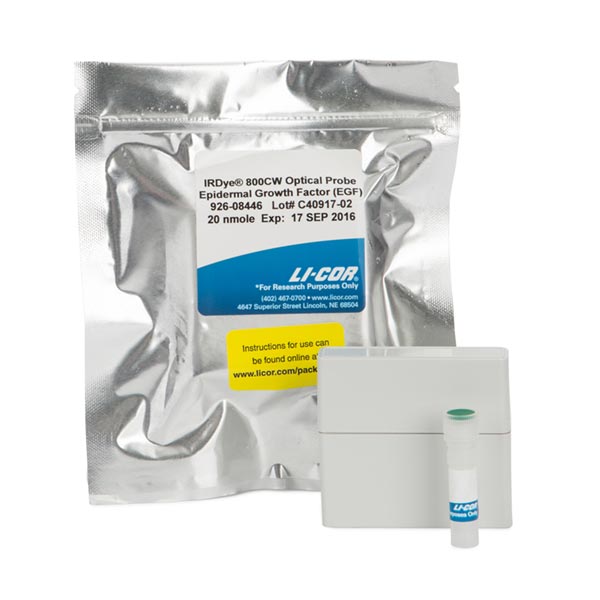IRDye 800CW EGF Optical Probe is a near-infrared (NIR) fluorescently-labeled recombinant human epidermal growth factor (EGF). This optical imaging agent is composed of a recombinant EGF polypeptide containing 54 amino acid residues (molecular weight = 6.2 kDa) conjugated to the LI-COR IRDye 800CW infrared dye.
IRDye 800CW EGF provides a versatile probe that can be used for in vitro and in vivo assays, as well as whole organ and tissue section analysis. In vivo assays of EGF binding have proven effective in monitoring specific solid tumor models that exhibit overexpression of EGFR.
Epidermal growth factor receptor (EGFR) is one of a family of receptor tyrosine kinases found on the surface of epithelial cells, to which EGF binds. Many types of cancer cells have abnormally high EGFR levels on the cell surface (table below).
| Tumor Type | % of Tumors Over-Expressing EGFR |
|---|---|
| Head and Neck | 80-100 |
| Renal Cell | 50-90 |
| Non-small-cell Lung | 40-80 |
| Glioma | 40-63 |
| Ovarian | 35-70 |
| Bladder | 31-48 |
| Pancreatic | 30-50 |
| Colon | 25-77 |
| Breast | 14-91 |
Frequency of elevated EGFR expression in different types of epithelial tumors1.
Learn about other LI-COR optical probes.
Applications
- In-Cell Western™ Assay
- Microscopy
- On-Cell Western Assay
- RNAi Screens
- Optical Probe Development
- Target Specificity
- Tissue Section Imaging
Absorbance and Emission Spectra

Determine Binding Specificity with IRDye 800CW EGF
In-Cell Western assays on the Odyssey® CLx, Odyssey Classic, or Odyssey Sa Infrared Imaging Systems were used to determine binding specificity of the probe in vitro for various cell lines.

In vivo Data Example

References
- Herbst, R.S., & Shin, DM (2002). Cancer, (94) 5 DOI 10.1002/cncr.10372.10372.
- Kovar, J. L., Volcheck, W. M., Chen, J., & Simpson, M. A. (2007). Anal Biochem, 361(1), 47–54. doi: 10.1016/j.ab.2006.11.021.
